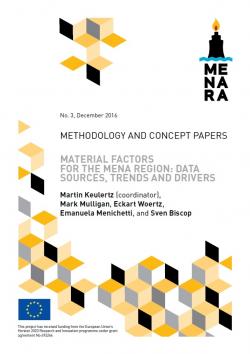Material Factors for the MENA Region: Data Sources, Trends and Drivers
This background paper on material factors in the MENA region selects key datasets for understanding past and present demographic, environmental, energy, economic and military transformations. It introduces the key literature relating to each factor and it identifies the most appropriate databases to assess the conditions in the MENA region. Using these databases, the ways in which material factors are subject to transformation are illustrated through graphs that underpin the central issues. Finally, the paper concludes with an assessment of the relative role of material factors in shaping the regional order and the policy options available to the European Union. To do so, it provides a list of scenarios that will be used by Work Package 3 to build a MENARA interactive tool based on the already existing WaterWorld platform and other international datasets.
-
Details
Roma, IAI, December 2016, 43 p. -
In:
-
Issue
Methodology and Concept Papers 3
Introduction
1. Demographic Transformations
1.1 Key Datasets
1.2 Key Drivers for the MENA Region (1950-Present): Population Growth, Urbanization, Youth and Migrations
2. Environmental Factors
2.1 Key Datasets
2.2 Key Drivers for the MENA Region (1960-Present): Population Growth, Climate Change, Water Scarcity, Soil Degradation and Food Availability
3. Energy Factors
3.1 Key Datasets
3.2 Key Drivers for the MENA Region (1970-Present): Energy Production, Energy Consumption and Technology
4. Economic Factors
4.1 Key Datasets
4.2 Key Drivers for the MENA Region (1990-Present): Growth, Job Creation, Inequalities, Subsidies and Remittances
5. Militarization Factors
5.1 Key Datasets
5.2 Key Drivers for the MENA Region (1990-Present): Arms Supplies, Military Expenditure and Conflicts
6. Relative Role of Material Factors in Shaping the Regional Order
7. Priority Areas for Research
Conclusions
References



